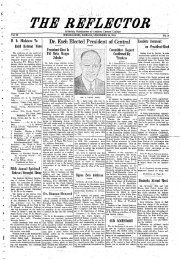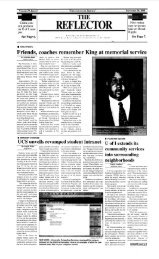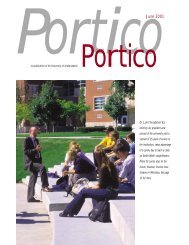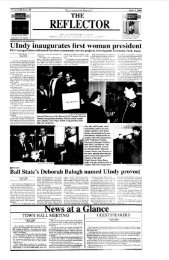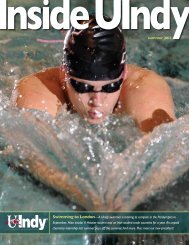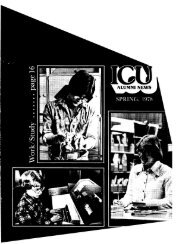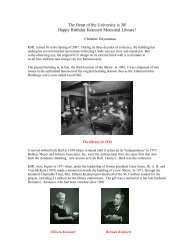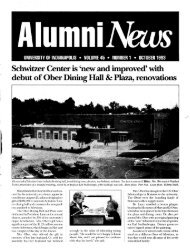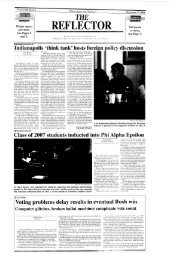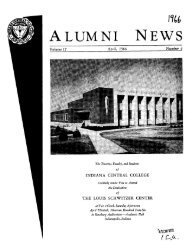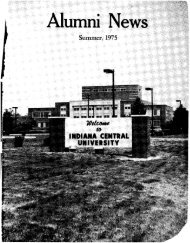the reflector - Frederick D. Hill Archives - University of Indianapolis
the reflector - Frederick D. Hill Archives - University of Indianapolis
the reflector - Frederick D. Hill Archives - University of Indianapolis
Create successful ePaper yourself
Turn your PDF publications into a flip-book with our unique Google optimized e-Paper software.
THE REFLECTOR PAGE<br />
~~ ~<br />
4 FEATURE MARCH<br />
27,2002<br />
CENTENNIAL SERIES<br />
<strong>University</strong> historian completes book in time for U <strong>of</strong> I centennial<br />
Gretchen Rush<br />
Editor-in-Chief<br />
Tucked away on <strong>the</strong> second floor <strong>of</strong><br />
Krannert Memorial Library, next to <strong>the</strong><br />
Writing Lab, is a small <strong>of</strong>fice that<br />
contains pictures, letters, minutes and<br />
memorabilia that document <strong>the</strong> entire<br />
history <strong>of</strong> <strong>the</strong> <strong>University</strong> <strong>of</strong> Indianapo-<br />
lis. Often overlooked by students, this<br />
<strong>of</strong>fice contains black-and-white photos<br />
<strong>of</strong> Good Hall surrounded only by grass<br />
and yellowed posters promoting a<br />
college named “Indiana Central.” This<br />
<strong>of</strong>fice is <strong>the</strong> <strong>University</strong> <strong>of</strong> <strong>Indianapolis</strong><br />
<strong>Archives</strong>, and it is <strong>the</strong> place where Dr.<br />
Fred <strong>Hill</strong> worked for 13 years on a<br />
book that covers <strong>the</strong> 100-year history<br />
<strong>of</strong> <strong>the</strong> institution.<br />
In 1989, at <strong>the</strong> request <strong>of</strong> President<br />
G. Benjamin Lantz, <strong>Hill</strong> began<br />
working on what developed into <strong>the</strong><br />
current 400-page book, ‘‘ ‘Downright<br />
Devotion to <strong>the</strong> Cause’: A History <strong>of</strong><br />
<strong>the</strong> <strong>University</strong> <strong>of</strong> <strong>Indianapolis</strong> & Its<br />
Legacy <strong>of</strong> Service.” The title <strong>of</strong> <strong>the</strong><br />
book was inspired by a quotation from<br />
U <strong>of</strong> 1’s third president, Irby J. Good.<br />
Because <strong>Hill</strong> taught more than 20<br />
history and religion courses at U <strong>of</strong> I<br />
from 1958-1988 and has worked as <strong>the</strong><br />
university historian since his retire-<br />
ment, His connection with that history<br />
<strong>of</strong> <strong>the</strong> university expands beyond<br />
research. He has participated in more<br />
than 40 years <strong>of</strong> <strong>the</strong> history. However,<br />
when <strong>Hill</strong> started working on <strong>the</strong> book,<br />
no previous effort had been made to<br />
document <strong>the</strong> university’s history. As a<br />
result, <strong>Hill</strong> conducted years <strong>of</strong> in-depth<br />
research.<br />
Nei<strong>the</strong>r <strong>Hill</strong> nor <strong>the</strong> former presi-<br />
dent intended for <strong>the</strong> project to last 13<br />
years or to be finished to coincide with<br />
<strong>the</strong> Centennial Celebration, but <strong>Hill</strong><br />
found boxes <strong>of</strong> minutes, catalogs and<br />
papers dating as far back as 1905. He<br />
read every page.<br />
“How some <strong>of</strong> it still happened to<br />
be here, I don’t know,” said <strong>Hill</strong>. “I<br />
found minutes from 1907 in a vault in<br />
<strong>the</strong> accounting <strong>of</strong>fice.”<br />
In <strong>the</strong> basement <strong>of</strong> Esch Hall, <strong>Hill</strong><br />
also discovered boxes full <strong>of</strong> minutes<br />
from various meetings, including an<br />
Indiana Central <strong>University</strong> (ICU)<br />
catalog from 1905 and an almost<br />
complete collection <strong>of</strong> an ICU publica-<br />
tion, <strong>the</strong> Bulletin, dating back to 1908.<br />
President Good’s family also donated<br />
nine or 10 boxes <strong>of</strong> his papers from his<br />
29 years as president <strong>of</strong> <strong>the</strong> university.<br />
The biggest hurdle <strong>Hill</strong> had to cross<br />
while researching <strong>the</strong> book was finding<br />
living people who could help document<br />
U <strong>of</strong> 1’s early years. “I was on<br />
<strong>the</strong> borderline <strong>of</strong> survival <strong>of</strong> people I<br />
needed to talk to,” said <strong>Hill</strong>.<br />
Twice <strong>Hill</strong> contacted people<br />
connected to <strong>the</strong> university, and didn’t<br />
get to discuss <strong>the</strong> history <strong>of</strong> <strong>the</strong><br />
university with <strong>the</strong>m because <strong>the</strong>y died<br />
within a week <strong>of</strong> <strong>the</strong> initial conversations.<br />
His biggest living resource for<br />
<strong>the</strong> book was Don Carmony. Carmony<br />
was an Indiana Central student and<br />
long-time trustee. Now 92, he enrolled<br />
at ICU as a student at age 15.<br />
“He was <strong>the</strong> only trustee [still alive]<br />
with <strong>the</strong> crucial transition from<br />
President Esch to Good,” said <strong>Hill</strong>.<br />
“He was a tremendous resource to me<br />
on this book.”<br />
The book contains 15 chapters and<br />
three topical essays that cover important<br />
U <strong>of</strong> I events throughout <strong>the</strong> past<br />
100 years. <strong>Hill</strong>’s favorite chapter,<br />
called “Some ‘Good’ Myths Dispelled,”<br />
explains that some rumors told<br />
about President Good are untrue.<br />
Although that is his favorite<br />
chapter, <strong>Hill</strong> said that Chapter 15,<br />
“The Legacy <strong>of</strong> Service,” is <strong>the</strong> climax<br />
<strong>of</strong> his book because it shows how<br />
strategic plans form and grow throughout<br />
<strong>the</strong> years.<br />
“It’s an amazing story, with all odds<br />
against us,” said Peter Noot, director<br />
for publications. “Faculty went years<br />
without getting paid, and <strong>the</strong>y were<br />
incredibly patient-and creditors, too.”<br />
Noot has known <strong>Hill</strong> since <strong>the</strong> mid-<br />
1970s, when he took <strong>Hill</strong>’s world<br />
civilizations class. “I’m surprised he<br />
still speaks to me because I was always<br />
really sleepy,” said Noot. “We had<br />
world civ. discussions Friday mornings<br />
at 7:30 or 7:45. It was brutal, but he<br />
always kept things interesting.”<br />
After his undergraduate days, Noot<br />
became <strong>the</strong> retired pr<strong>of</strong>essor’s col-<br />
league. Their jobs <strong>of</strong> historian and<br />
publisher intertwined to complete<br />
<strong>Hill</strong>’s book, and <strong>the</strong> two have worked<br />
closely toge<strong>the</strong>r since November to<br />
prepare <strong>the</strong> book for publication.<br />
“He has treated me like a colleague<br />
always, and that’s been really a joy,”<br />
said Noot. “He’s done a thousand tons<br />
<strong>of</strong> work, and I came in at <strong>the</strong> end and I<br />
put it in <strong>the</strong> pages.”<br />
Noot said that like his classes,<br />
<strong>Hill</strong>’s explanations are clear because<br />
he makes connections that allow <strong>the</strong><br />
reader to see <strong>the</strong> big picture as well as<br />
<strong>the</strong> intricate details.<br />
“While I read <strong>the</strong> book, <strong>the</strong> most<br />
fun for me was that it made those early<br />
years in particular more vivid, and I<br />
felt <strong>the</strong> connection to those early<br />
years,” said Noot. “It made <strong>the</strong> growth<br />
<strong>of</strong> <strong>the</strong> university palpable. You could<br />
almost see <strong>the</strong> buildings going up.”<br />
Dr. Lynn Youngblood, vice<br />
president and provost and assistant<br />
pr<strong>of</strong>essor emeritus <strong>of</strong> math, has known<br />
<strong>Hill</strong> for 40 years. He, too, had <strong>Hill</strong> as a<br />
pr<strong>of</strong>essor-for history <strong>of</strong> western<br />
civilization and three religion courses.<br />
“He was a true scholar, and yet he<br />
came across as someone who knew<br />
how to relate very well,” said<br />
Youngblood. “Because <strong>of</strong> <strong>the</strong> way he<br />
taught his courses, I had a deeper<br />
appreciation for <strong>the</strong> importance <strong>of</strong><br />
history and certainly for <strong>the</strong> complexity<br />
<strong>of</strong> religion. I am sure I am a more<br />
rounded individual and a more<br />
cosmopolitan thinker.. ..He was among<br />
<strong>the</strong> faculty that taught me how to think<br />
without imposing <strong>the</strong>ir own personal<br />
views.”<br />
Jay Starks, administrative assistant<br />
for Career Services, worked part-time<br />
as <strong>the</strong> university’s assistant archivist<br />
from 1994-2001. She interacted with<br />
<strong>Hill</strong> on a daily basis for seven years.<br />
“I learned so much from him, and I<br />
never once felt like he was telling me<br />
how to do things,” said Starks. “I feel<br />
that <strong>the</strong> seven years I spent with Fred<br />
every day were probably more valuable<br />
than any college degree I could<br />
have gotten.<br />
“He has this marvelous memory. If<br />
anything has impressed me so much it<br />
is that he can remember dates and<br />
names.. ..We had a timeline, and I<br />
always had to refer to <strong>the</strong> timeline.<br />
Fred knew <strong>the</strong> date to everything that<br />
happened here .... without looking it<br />
up-and he was always right.<br />
“He loves this university. I think<br />
it’s really special that Fred is writing<br />
<strong>the</strong> book because <strong>of</strong> <strong>the</strong> devotion he<br />
has to <strong>the</strong> university.. . .He was all<br />
about making this school a better place<br />
and making his lifetime career here<br />
helping students.”<br />
<strong>Hill</strong>’s book is currently in printing.<br />
Within <strong>the</strong> next month, 500 hardback<br />
($20) and 2000 paperback copies ($10)<br />
will be available for purchase in <strong>the</strong><br />
university bookstore, online and at<br />
campus events. The Celebration <strong>of</strong> <strong>the</strong><br />
Presidents on May 3 1 will be <strong>the</strong> first<br />
campus event to showcase <strong>the</strong> book.<br />
“It would be a crime if anyone else<br />
had written this history,” said Noot. “I<br />
swear he knows each alumnus and<br />
alumna personally, and he remembers<br />
<strong>the</strong> family connections and where<br />
everybody’s from. It’s just amazing<br />
, , ‘ I<br />
Photo by Gretchen Rush<br />
HE’S DONE IT ALL-Dr. Fred <strong>Hill</strong> works on his book on <strong>the</strong> history <strong>of</strong><br />
U <strong>of</strong> I last year. <strong>Hill</strong> has been with <strong>the</strong> university since 1958.<br />
Do you know an interesting<br />
person who should be pr<strong>of</strong>iled by<br />
The ReflectoJ,<br />
Send your ideas to<br />
<strong>reflector</strong> @ uindy edu<br />
STUDENTS* * * * * RECEIVE 10%



